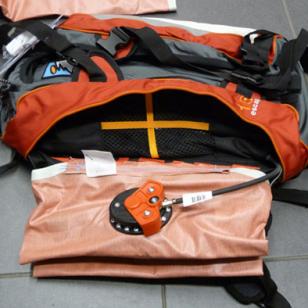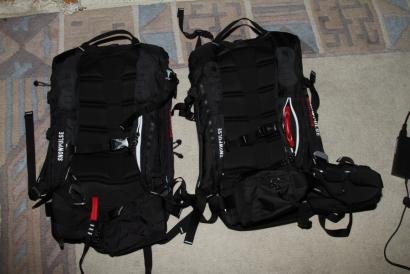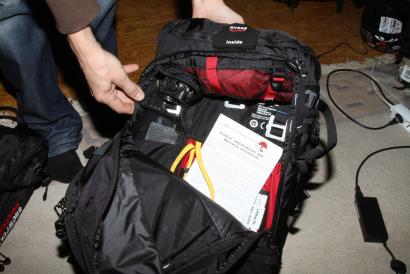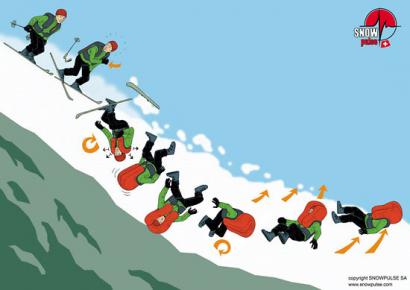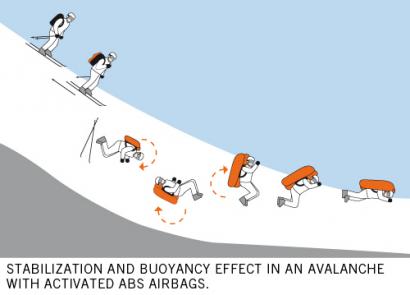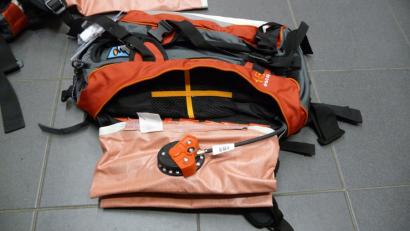Avalanche backpacks ABS and SnowPulse
Description and technology of two major producers of avalanche backpacks
Avalanche backpack is not an ordinary backpack, thanks to an inflatable bag which can greatly increase the volume of the rider and thanks to physics of materials movement can keep the skiers on the surface of the avalanche. This principle works only when you are in an avalanche in motion (see photo). Not when you are in still position and are regaled. Currently we have two major players on the market who took this principle described above and thus evocate a debate about the accuracy of the system, which this article will be about. Assessment and evaluation of these two types is largely is irrelevant because you just cannot repeat the exactly same test conditions. The basic is that the larger objects remain on the surface or are slightly submerged. This basically applies at all times.
The first player on the market with this kind of backpack was ABS and that is why I´ll start with an overview and specifications of the brand. Due to the past time when these bags appear on the market we can now look forward to this season and expect many improvements and innovations in it. The core is the change of the concept of the backpack. Backpack is divided into two parts: a basic unit + cover (actual volume). This means that you buy a base unit and thanks to a zipper add the second part of the bag with size you need. This season ABS has two tapes of this base units separated by size, weight and the volume variations of parts. The advantage of this is to have an option and opportunity to purchase this second part volume from other companies, such as Arva, Dynastar, etc. to create your backpack design and volume that meets your needs.
The principle of ABS backpacks is as follows. After you trigger it, it starts to inflate into two independent air bags on the back area. The main thing in this is a pressured bomb filled with combination of gas argon and nitrogen in 60grams. When it’s being activated there is a vacuum created, which "collects" the oxygen from the surrounding environment and thus make up the remaining amount of needed for both bags. You can buy this bomb from carbon and thus reduce the weight about 50% to 280 grams, comparing the regular made of steel which has over 500grams. Another part is the trigger, which is equipped with a cartridge. This trigger after you start it up will send a shock wave which thanks to the membranes in the tubing pressure adjusts the pressure to a punch which breaks through the membrane into the pressure bomb. Therefore you always must place the pressure bomb first. Failer to do so can coz to ripping all the membranes in the pressure hose and you have to repair it for about 75Euro. This year's air bags with a capacity of 170 liters are woven. Thanks to this they are more durable and lighter than the currently used polyurethane. Another new feature is the ability to remotely trigger the backpack. This equipment is sold separately and is placed instead of the regular trigger. By combining with the other bags you can trigger all backpack at once or to a friend as you previously adjusted. The range is about 300m.
Another strong producer of these systems is Snowpulse company. Their bags have come a little bit later than ABS with a slightly different processing of the above-mentioned principles. Air bag with the capacity of 150l is not inflated on your back, but around the shoulders and head. Backpacks Snowpulse are supplied in a one piece, so you need to select you size in advance 15, 30 or 40l. New feature for this year´s re-make back system, the size of the pressure bomb, harness and mounting system. The offer is extended to another model with size 30l, the Highmark, which is designed for riders on snowmobiles. The function of triggering is based on simpler basis. Handle that you pull out into emergency position, before your run, is connected to a steel cable directly to a valve (see photo). To start it you need power of 6 kg. On ABS backpack you need about 8 kg. Once it´s is being activated it begins to inflate the bag through the hole in the zipper right behind the neck. In this part the zip is not zipped. Therefore you must always check that you zip the bag as instructed. The pressure bomb is filled to a pressure of 300bar, which is equipped with a manometer. The pressure varies depending on ambient temperature. If you want to refill the pressure bomb, you can send it to a specialized shop or find a diving centre.
Users of both brands roughly argue about which of this system is better. This is mainly due to their different needs. ABS backpacks are focused on the needs of professional rescuers and that is why the rescue team use this backpack. There are also rules that are based on their work in saving. For example they have to enter into an open avalanche field with ABS. These backpacks require greater knowledge of the system and maintenance. Snowpulse again is based on the simplicity of the system. The inflated Snowpulse gives you greater protection of the head, but it reduces the visibility. Thanks to that subsequent rescue work with beacon is more difficult, but in needs of pure freerider is not important, I guess.
We decided to address this article to Czech importers of these brands and as users test it during the season. After the first month of use, we will bring to each type of backpack user's introduction of specific model Snowpulse 15, 30 and ABS Base Unit + Vario Ultralight. At the end of the season will publish the final user´s review.
Text: Martin Knybel



